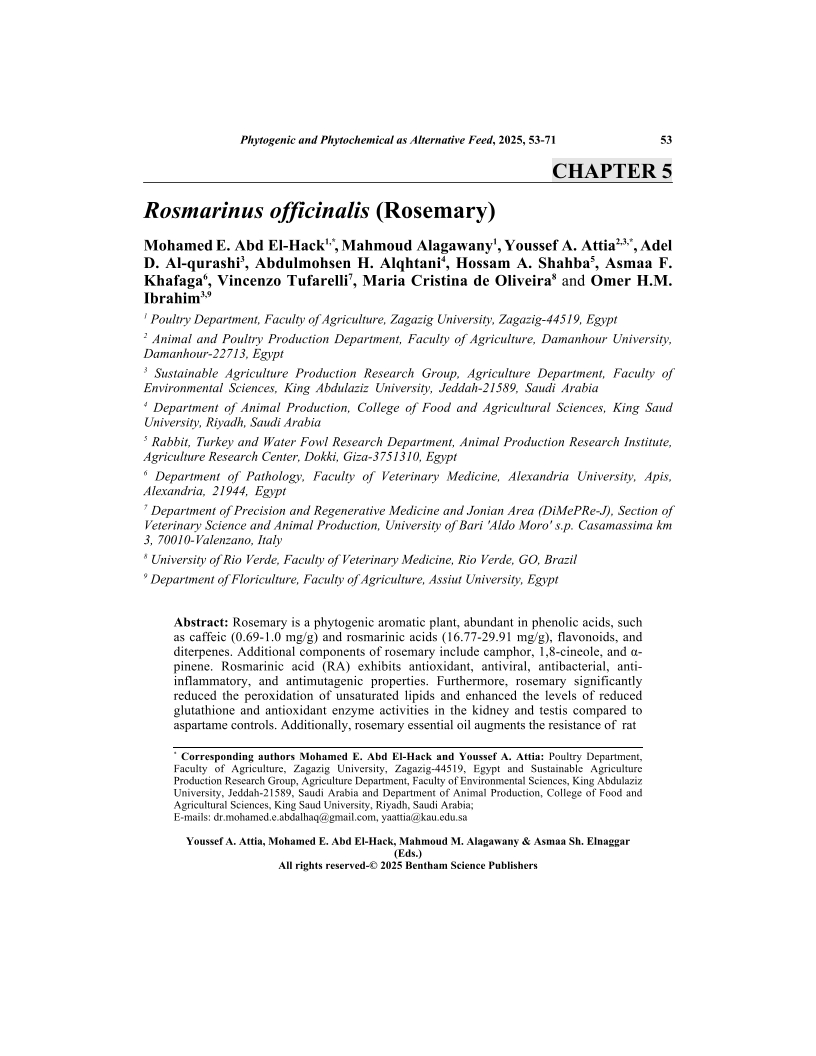Rosmarinus officinalis (Rosemary)

- Authors: Mohamed E. Abd El Hack1, Mahmoud Alagawany2, Youssef A. Attia3, Adel D. Al-qurashi4, Abdulmohsen H. Alqhtani5, Hossam A. Shahba6, Asmaa F. Khafaga7, Vincenzo Tufarelli8, Maria Cristina de Oliveira9, Omer H.M. Ibrahim10
-
View Affiliations Hide Affiliations1 Poultry Department, Faculty of Agriculture, Zagazig University, Zagazig-44519, Egypt 2 Poultry Department, Faculty of Agriculture, Zagazig University, Zagazig-44519, Egypt 3 Animal and Poultry Production Department, Faculty of Agriculture, Damanhour University, Damanhour-22713, Egypt 4 Sustainable Agriculture Production Research Group, Agriculture Department, Faculty of Environmental Sciences, King Abdulaziz University, Jeddah-21589, Saudi Arabia 5 Department of Animal Production, College of Food and Agricultural Sciences, King Saud University, Riyadh, Saudi Arabia 6 Rabbit, Turkey and Water Fowl Research Department, Animal Production Research Institute, Agriculture Research Center, Dokki, Giza-3751310, Egypt 7 Department of Pathology, Faculty of Veterinary Medicine, Alexandria University, Apis, Alexandria, 21944, Egypt 8 Department of Precision and Regenerative Medicine and Jonian Area (DiMePRe-J), Section of Veterinary Science and Animal Production, University of Bari 'Aldo Moro' s.p. Casamassima km 3, 70010-Valenzano, Italy 9 University of Rio Verde, Faculty of Veterinary Medicine, Rio Verde, GO, Brazil 10 Sustainable Agriculture Production Research Group, Agriculture Department, Faculty of Environmental Sciences, King Abdulaziz University, Jeddah-21589, Saudi Arabia
- Source: Phytogenic and Phytochemical as Alternative Feed Additives for Animal Production , pp 53-71
- Publication Date: March 2025
- Language: English
Rosmarinus officinalis (Rosemary), Page 1 of 1
< Previous page | Next page > /docserver/preview/fulltext/9789815322767/chapter-5-1.gif
Rosemary is a phytogenic aromatic plant, abundant in phenolic acids, such as caffeic (0.69-1.0 mg/g) and rosmarinic acids (16.77-29.91 mg/g), flavonoids, and diterpenes. Additional components of rosemary include camphor, 1,8-cineole, and αpinene. Rosmarinic acid (RA) exhibits antioxidant, antiviral, antibacterial, antiinflammatory, and antimutagenic properties. Furthermore, rosemary significantly reduced the peroxidation of unsaturated lipids and enhanced the levels of reduced glutathione and antioxidant enzyme activities in the kidney and testis compared to aspartame controls. Additionally, rosemary essential oil augments the resistance of rat hepatocytes against DNA-damaging oxidative agents and serves as an effective free radical scavenger. Caffeic and rosmarinic acids have demonstrated potential in the treatment of inflammatory diseases and hepatotoxicity. Rosemary is also rich in phytochemical derivatives such as triterpenes, flavonoids, and polyphenols. This review will focus on the beneficial effects of rosemary and its application in improving the productive performance and health of livestock.
-
From This Site
/content/books/9789815322767.chapter-5dcterms_subject,pub_keyword-contentType:Journal -contentType:Figure -contentType:Table -contentType:SupplementaryData105

